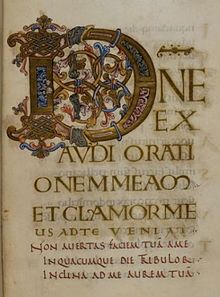


The Psalter of Oswald also called the Ramsey Psalter (British Library, Harley MS 2904) is an Anglo-Saxon illuminated psalter of the last quarter of the tenth century.[1] Its script and decoration suggest that it was made at Winchester, but certain liturgical features have suggested that it was intended for use at the Benedictine monastery of Ramsey Abbey in Huntingdonshire (now Cambridgeshire), or for the personal use of Ramsey's founder St Oswald.
The litany includes a gold-lettered triple invocation of St Benedict of Nursia, and at the time of writing, probably before Oswald's death in 992, Ramsey was the only English monastery dedicated to this saint. A "Psalter of St Oswald" was listed in a 14th-century catalogue of the library at Ramsey.[2] This manuscript is not to be confused with another Ramsey Psalter in the Morgan Library & Museum, New York (MS M. 302), made between 1286 and 1316.
The text is a Latin psalter using the Gallican version. The "elegant English Caroline minuscule" of the script inspired the influential "foundational hand" developed by the 20th-century calligrapher Edward Johnston.[3]
The two most famous illuminated pages are at the start of the manuscript and are illustrated here and discussed below. Apart from another very large illuminated initial at the start of Psalm 101, the rest of the illumination consists of smaller decorated initials with colour at the start of each psalm, and gold initials for each verse.[4]
© MMXXIII Rich X Search. We shall prevail. All rights reserved. Rich X Search
